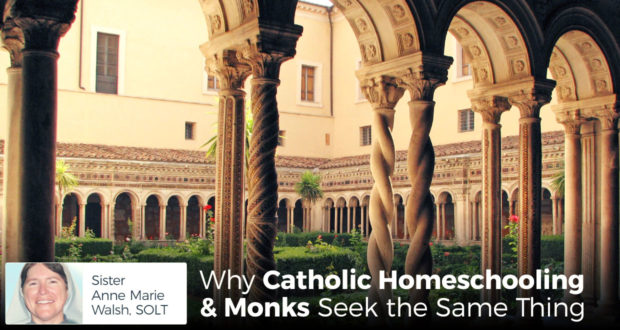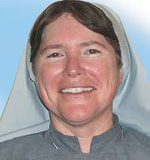It can be challenging to look at the world today and to remember the words of Scripture: “…where sin increased, grace overflowed all the more” (Rms. 5:20).
We know the Gospel’s relevance is timeless. However, understanding the way in which it penetrates a specific period in time requires a creativity found only in the Holy Spirit, Who searches the hearts of men and applies the deep things of God within concrete historical situations.
Pope Benedict XVI, meeting with representatives from the world of culture at the Collège des Bernardins, Paris, in 2008, addressed the threats to modern culture by drawing attention to the roots of Western Civilization.
In particular, he considered monasticism and its development, noting that,
“Amid the confusion of the times, in which nothing seemed permanent, they (the monks) wanted to do the essential – to make an effort to find what was perennially valid and lasting, life itself. They were searching for God. They wanted to go from the inessential to the essential, to the only truly important and reliable thing there is…Quaerere Deum, to seek God.”
Whether on the mainland (Europe) or in Celtic lands, the establishment of monastic communities was ordered to a life that was conducive to finding God and to living out a covenantal relationship with Him.
The daily communal life of the prayer and work of Christ became a seal against the chaos and barbarism of the times, a stamp of the deeper Gospel message that brought order, meaning, and ultimately, great cultural development.
It should not surprise us that the biblical principles by which the monks lived and their deep study and contemplation of the mysteries of God, started to leaven the secular order, so that time, learning, art, music, animal husbandry, farming, care of the poor, all began to be marked by the laws and light which God Himself had put into creation.
An order and a fruitfulness developed that actually had heavenly origins. The bells announcing the call to prayer, which punctuated each day, and the liturgical seasons with their abundance of solemnities, feasts, and even the rich Gospel lessons of ordinary time, made the meaning of life, one’s responsibilities, one’s destiny, readily understood.
And though there were variations of monastic tradition and development between the mainland and the Celtic lands, the essentials were the same: “the supreme good of knowing Christ Jesus”…(Phil 3:8), in light of which all else is rubbish.
Monasticism did not begin as an attempt to create a new culture or civilization. The holy men and women of those times were interested in the one thing necessary. The impact upon the surrounding culture, even when efforts to evangelize became more direct, was quite in accord with the words of Christ: “Seek first the kingdom (of God) and his righteousness, and all these things will be given you besides” (Mt 6:33).
The Catholic homeschooling movement in our present age has, at its heart, this same seeking of the monks. It is a response to a loss of vision. Caryll Houselander, in her book, Guilt, noted that “The great repression of our age is the repression of Christ in man” (p85). Nowhere is this more evident than in secular education.
We live in a time that has known Christ and now rejects Him. Given this, we cannot wonder that man no longer understands himself: apart from Christ it is not possible, “For in Christ were created all things in heaven and on earth, the visible and invisible, whether thrones or dominations, or principalities or powers, all things were created through Him and for Him. He is before all things and in Him, all things hold together” (Col 1:16-17).
He is the pattern, the form of our own identity and destiny. His life must be allowed to grow in us. Apart from Him, everything begins to disintegrate, both interiorly and exteriorly, individually and communally. Our own time witnesses to this with alarming clarity.
However, in Catholic homeschooling, genuine education seeks to assist the child in developing into the fullness of all that God has created him or her to be. This kind of education involves heart, mind and soul and fulfills its purpose by forming children to Christ, preparing them ultimately to see God face to face.
In coming to the full measure of the mature Christ, children become natural evangelizers in all the realms of human activity in which they may engage: intellectual, physical, scientific, academic, artistic, apostolic, spiritual. The Christ-life within is the essential thing in the midst of the contemporary bombardment of the inessential and the society’s growing barbarism. The Christ-life is a gift that one begins to yearn to give for the happiness of others.
The path of a movement such as Catholic homeschooling is provided by God, just as it was for monasticism, in His Word and in the rich teachings and traditions of the Church. A beautiful image for today is of little domestic monasteries where children are formed to true humanity.
With authentic education, they begin to become, not in a forced way, but in a supernaturally natural development, little Christs touching the world in the activities of their childhood and adolescence. Finally, in adulthood, they become an even greater leaven as they take their places in the world.
Pope St. John Paul II often pointed out that the Church and the world are at a crossroads. He exhorted us to commit to a New Evangelization in order to usher in a new springtime of Christianity. He also warned us that if we do not follow the movements of the Holy Spirit, we will see a new age of barbarism.
Among the great signs of hope, we can claim Catholic homeschooling as one of the harbingers of the formation of the new man and a new springtime, knowing that, “a Christian has only to be, in order to change the world” (C. Dawson, Christianity and the New Age).
Cloister CC Fr Lawrence Lew | Flickr

 Seton Magazine Catholic Homeschool Articles, Advice & Resources
Seton Magazine Catholic Homeschool Articles, Advice & Resources

